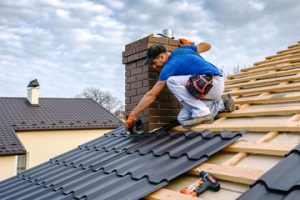A well-maintained roof will extend the lifespan and prevent costly repairs. By being proactive about maintenance and addressing issues as they arise, you can save thousands of dollars over the lifetime of your home.

Inspect shingle roofs regularly, particularly in the spring and fall, for signs of missing or damaged shingles. Clean gutters frequently, as they play a vital role in directing water away from the roof and foundation of your home. Contact Five Star Roofing and Contracting for professional help.
A roof inspection is a vital preventative measure that helps homeowners identify potential issues, such as small leaks or early signs of mold and wear. When caught and addressed quickly, these minor problems can be corrected before they escalate into expensive repairs or even a full replacement. Keeping up with regular roof inspections can also reduce repair costs and extend the lifespan of your roofing system.
A professional home inspector typically provides a detailed assessment of the condition of the roofing system and offers recommendations for any necessary repairs or maintenance. They may use photographs and measurements to document the findings, as well as provide cost estimates for recommended work. A thorough inspection includes a detailed description of the roofing material, along with a summary of any damage or deterioration. It also covers the state of gutters, downspouts, flashings, skylights, chimneys and vents. The report should also note the roof’s structural integrity, including sagging areas and weakened support structure.
Depending on the type of roofing material, the inspection process can vary in duration. For example, tile and slate roofs require a more thorough evaluation due to their fragility. Metal roofs also necessitate special attention to seams and fasteners, which can increase inspection time. Additionally, ensuring easy access to the attic and roof area is essential for a complete assessment. This can include trimming back overhanging branches and relocating items near attic entrance points.
Your inspector will also assess the condition of exterior siding, doors and windows; the condition of the foundation, basement and crawl spaces; and ventilation and insulation. They’ll also check the condition of the electrical system, including the service drop, electric meter, panelboards and over-current protection devices. Inspectors will test for GFCIs where appropriate, and inspect smoke and carbon monoxide detectors.
Homeowners should review their home inspector’s report carefully and make notes on any areas of concern. They should prioritize recommended repairs based on the severity of any identified issues and their budgets. A well-maintained roof can boost resale value, which makes it an important investment. It can also help prevent costly repair bills, minimize the need for future roof repairs and improve overall home safety and comfort.
Trimming
Keeping branches and overhanging vegetation trimmed is a key element in effective roof maintenance. Untrimmed limbs can scrape the surface of shingles during windy days and create a breeding ground for mold and mildew, which can impact the lifespan of roofing materials. Debris from overhanging trees also may clog gutters, causing water damage to the home’s structure and facilitating leaks.
It’s recommended that homeowners clean and repair gutters twice a year. This prevents clogs, and reduces debris that can trap moisture and encourage algae and moss growth. Keeping the grass and shrubs trimmed and away from the sides of the house also helps prevent soil erosion and moisture buildup.
In addition to regular cleaning and a periodic roof inspection, it’s a good idea to have a roofing professional perform a thorough cleaning once a year. This includes removing accumulated dirt, leaves and twigs, as well as examining the roof for damage or potential problems like moss or lichen growth. A roofing professional can remove these organisms using a special chemical solution that is safe for the roof’s coating and can help prevent re-growth.
The most important thing a homeowner can do to protect their roof is to maintain surrounding landscaping and trees. This helps protect against storm damage, promotes air circulation and minimizes the effects of sun exposure on the roof’s surface. It’s recommended that homeowners hire a certified arborist to ensure they are getting the proper tree trimming services to safeguard their metal roof.
Properly maintained trees also help improve the aesthetic of a property, showcasing attractive species and healthy bark. And they can enhance the value of a residential property by protecting it against rodents and preventing the need for costly repairs from tree branch damage.
The best time to perform regular tree service is in the spring and fall, when weather conditions are more temperate. This prevents the stress of summer storms, and it’s also easier to keep foliage trimmed when the weather is cooler. This is when the majority of the species that grow near roofs are in full bloom, so their colors and foliage are at their most vibrant.
Sealant
Sealants can enhance a roof’s protective capabilities and help mitigate damage to shingles, tiles or other materials. They are especially valuable for resealing cracks or gaps that can quickly grow into larger problems, and they are ideal for preemptively addressing vulnerable spots around fasteners, nails, solar panels, chimneys, skylights and other elements that pose leak risks.
Sealant options range from sprays and coatings to caulks and tapes. High-strength silicone roof sealants can deliver cured film physical properties that are comparable to standard roofing membranes. They are designed to stand up to a variety of weather conditions, including UV exposure and temperature fluctuations.
Polyurethane sealants are another popular option for shingle or wood roofs. They typically have a lifespan of 10 to 20 years, and they provide exceptional adhesion, even on aged or damaged shingles. They are also resistant to foot traffic, so they’re ideal for commercial or residential use.
Silicone roof sealants can withstand extreme weather conditions, and their cured film physical properties are comparable to standard roofing membranes. They’re suitable for use on a variety of surfaces, including asphalt shingles and metal. They offer good water resistance and can withstand UV exposure, but they require regular maintenance to prevent peeling or cracking.
When applying any type of roof sealant, it’s crucial to clean the surface before starting and to choose a day with good weather. Rainy or hot temperatures can degrade the sealant’s durability, reducing its ability to protect the roof against environmental conditions.
Depending on the sealant, it may take between 24 and 48 hours to dry completely. During this time, it’s important to minimize foot traffic on the roof to protect against potential accidents and further damage.
Some sealants can leave a slippery residue, which can be a hazard for people walking on the roof. To avoid this risk, some professionals recommend incorporating walk pads or textured surface on areas of the roof that are regularly traversed by humans. In addition, it’s recommended to apply roof sealants during a dry period, which helps minimize slipperiness and ensures the product dries thoroughly for best results.
Flashing
Flashing may not be the first thing that comes to mind when thinking about roof maintenance, but it plays a crucial role in preserving the longevity of a home’s roofing system. Positioned at the intersections and edges of a roof structure, flashing covers seams between different materials like shingles and metal. By directing water and penetrating moisture away from these vulnerable areas, it helps prevent water infiltration, averting wood rot, mold growth, and other significant roofing problems.
Roof flashing is made from durable materials, but even the most resilient material won’t last forever. In a harsh environment like ours, moisture, temperature fluctuations, and physical stress can accelerate flashing deterioration, leading to damage and leaks.
Regular roof inspections can identify issues with flashing before they become serious and costly. These issues include rust and corrosion, loose or missing flashing, and cracks and gaps in flashing. If not repaired, these issues can leave critical parts of a roof exposed to moisture infiltration, compromising the structural integrity of the roofing system and the safety of the building occupants.
Flashing is typically made from durable metals like aluminum and steel, but these materials are not impervious to weathering. Frequent rainfall and exposure to salty air can cause flashing to corrode, while the frequent freezing and thawing cycles of our Pacific Northwest climate can weaken metal flashing and create cracks.
Depending on the location of the damage, it is important to consider what kind of impact the issue could have on the rest of the roof system. For example, a gap in flashing could lead to leaks throughout the entire roof and other areas of the house. This could require extensive and expensive roof repair, if not replaced entirely.
If you notice any signs of damage to your flashing, it is important to schedule a roof inspection with an experienced professional right away. Getting these problems addressed promptly will help protect the integrity of your roof system and your home, extending its lifespan for years to come.
